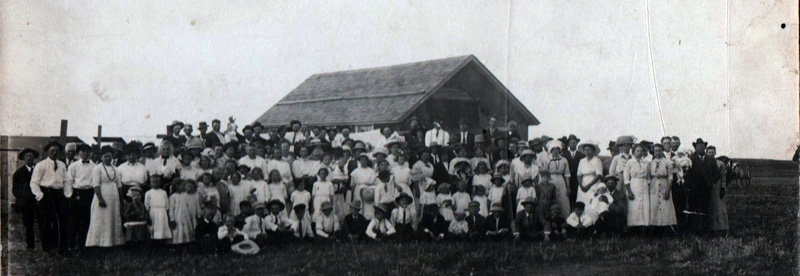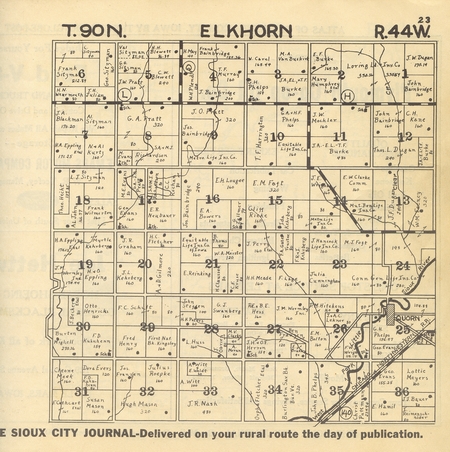LeMars Semi-Weekly Sentinel
June 26, 1891
PIONEER DAYS IN PLYMOUTH COUNTY
AN HISTORIC ACCOUNT OF THE EARLY SETTLEMENT, ORGANIZATION AND SUBSEQUENT
DEVELOPMENT OF THE COUNTY BY TOWNSHIPS
Interesting Reminiscences, Adventures, Amusing Incidents, and the Hardships
Connected with the County’s History from 1856 to 1891, Including the
“Homestead” and “Grasshopper” Days.
By W. L. Clark
CHAPTER XXI.
ELKHORN TOWNSHIP
Descriptive- Organization-First Settlement-Schools-First Events-A Big Wheat
Farm-Village of Quorn-First Railroad Pioneer Newspaper-Homesteaders
That portion of Plymouth county described by congressional township ninety
and range forty-four west is known as Elkhorn township. It is one the south
line of the county, with Garfield township to its east, Union on the south
and Lincoln on the west. Not unlike the remainder of Plymouth county, this
township is noted for its excellent land and fine natural drainage system,
formed by numerous creeks and rivers, among which may be mentioned the West
Fork, of the Little Sioux river, in the south and western portion; also
Muddy Creek, in the western part, leaving the territory from section four;
John’s creek is another small prairie stream. These principal water courses
are each supplied with many lesser feeders.
Elkhorn township was constituted a separate civil organization, by an act of
the board of county supervisors, dated September 3d, 1877. Prior to that
time it was included in Lincoln township. The population, which now numbers
486, in 1885 was only 350, 240 of which were American born.
The village plat of Quorn, on section twenty-five, was platted in September,
1880, but owing to the building up of the railroad town of Kingsley, a mile
to the east, it is now virtually defunct.
FIRST SETTLERS
In going about along well-improved highways, with excellent farms on either
hand attracting the attention of the passer by, the question naturally
arises, today, “Who was the first to claim land and build for himself a home
in this goodly territory?” By careful research among the pioneers, it is
learned that in 1876 Charles Bullis came from Franklin county, Iowa, and
purchased the land in the autumn of that year, on section twenty-six,
township ninety and range forty-four, which now constitutes Elkhorn civil
township. At that date there was not a house of any description to be seen
in Elkhorn’s eastern neighboring township of Garfield.
Four members of the family named Higday settled in the northwest corner of
the township. One moved away, two are deceased, and one named Joseph, is
still a resident.
Nearly all the pioneers of this township made homestead entries, George
Evans locating on the southwest quarter of section seventeen. John and
“Mike” Trow claimed land on the southeast of section seventeen. The former
is still living there, his brother, Gresh, who located on section nine is
now dead. A Mr. Mann settled along the west line of the township, and
remained until about 1886. Hugh Mason, who is still an honored resident,
effected a settlement on section thirty-one and thirty-two. J.J. Edwards
settled on section twenty-nine, but subsequently removed to another county.
P.J. Ward was one of the very earliest settlers, and is still a resident of
this township. He settled on section twenty-four, where he now enjoys the
fruit of his labors, in the possession of a most valuable farm, upon which
is situated a magnificent grove planted and cultivated by his own hands. S.
North settled on the north half of the southwest quarter of section
fourteen. He is now deceased. Henry Addington located on a part of section
twenty-four, but soon removed. A man named Cain settled on the northwest of
section thirty-two; and one named Bruseau on section twenty. They
subsequently removed to California.
From about 1877 settlement was made more rapidly. In 1876 the township had
about twenty voters within her borders.
EARLY EVENTS.
The first marriage in what now comprises Elkhorn was that of Arthur Dufty in
1872.
The first religious services were held at the Higday school house by Rev. C.
W. Batchelor, Methodist, in 1858.
The first death was that of Sarah North, in 1877, aged sixty-seven years.
The first child born was Emma Kane, in 1872.
The first term of school was taught in 1868, at the Higday school house. The
first school houses were erected on section thirty-two and section six—both
built the same year. As the settlers increased, new sub districts were made
and provided with good frame buildings until today the township has six
sub-districts each having a good school edifice. The total enrollment of
pupils in 1889 was 142. The schools are in excellent condition, and keep
pace with new educational methods in all respects.
Higday Sunday School Group Photograph

~Photo submitted by Tammy Jorgensen, found among her gg grandfather's things.
VILLAGE OF QUORN (defunct)
In the month of October, 1880, Close Bros. platted the village of Quorn on
section twenty-five of Elkhorn township. It was expected that the Chicago &
Northwestern Railway line would eventually be constructed through its
limits, but the company not liking the business style of the proprietors
they changed the route, platted Kingsley a mile to the east and left Quorn
off of the line or road, which fact forever blighted its hopes. However,
before this transpired, the village had commenced to thrive and put on
western city airs. Several general stores were being operated; a post office
was petitioned for and granted; and John Gaspar was the first to hold the
office of postmaster. A roller mill was built and operated by Heacock Bros.
and still does a paying business. Casper Brothers, Rathburn & Ireland and
Mr. Varnum all conducted good stores from which general goods and hardware
were sold. A newspaper known as the Lynx was established at this point in
1883 by Frank Calhoun, who subsequently removed it to Kingsley and gave it
the title of Kingsley Times.
With the oncoming of emigration and the push which always centers around a
new railroad town, the village of Quorn was left out in the cold, and now
may justly be classed among the defunct places of the county. But while
there remains nothing save the old mill and a few foundation stones,
together with a few residences, to remind the passer by of a townsite, yet;
so long as memory is theirs the old settler, the early pioneer of long ago
days, will often refer to Quorn and think of the good time fully come, when
they could get flour to eat and mail matter, including a home paper to read,
with in that now half deserted plat, the village of Quorn. |

